There are a lot of good non-corporate, creator-owned books out right now (this has been a great year for them), so let’s start with those this week:
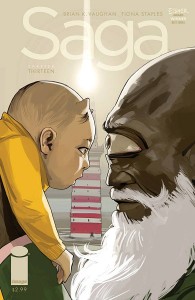 Saga #13 — Writer: Brian K. Vaughan; Art: Fiona Staples
Saga #13 — Writer: Brian K. Vaughan; Art: Fiona Staples
This is revving up again after a few months’ absence (the creative team takes a break after each six-issue volume), and the cover helps to show why Staples, the artist, has been such a big part of its becoming a hit: the eyes are drawn to the cute baby first, and the lifelike eyes, but then they notice the horns… and the fact that the adult is a Cyclops… and the futuristic lighthouse thing in the background… and, without any need for dialogue or cliche, it’s clear that this is a science-fiction book with a lot of character and heart. Readers expecting a resolution to the cliffhanger at the end of volume two will be disappointed, since this covers events before that scene — but the efficient-but-unhurried way it touches on all its sprawling cast, bringing new readers up to date subtly while moving their various interconnected plots along, shows just how good these people are at episodic storytelling. As a bonus, there’s a four-page letters section that lets readers get to know the creative team a little more, and helps connect everyone into a like-minded fan community. This is a model for how to build a successful creator-owned story in today’s market.
Walking Dead #113 — Writer: Robert Kirkman; Art: Charlie Adlard
I don’t mention this title much, but it continues to rocket along dependably, growing in circulation; it’s hard to imagine a fan of the TV series picking it up and not wanting to stick around. This episode’s a good example: plenty of cliffhanger action (Kirkman has become a master at playing on the audience’s awareness that any of these characters could die at any moment… or not), a fascinating and supremely dangerous bad guy who’s currently got the upper hand, and a last page guaranteed to bring everyone back next month — and all without a zombie in sight. This is another book with a chatty and funny letters page, too — one that mentions that this issue and next lead into to a 12-issue “All-Out War” arc meant as the climax to the last year and a half of stories. This is very different in tone from Saga, but similar in its focus on character, fan-friendliness and addictive storytelling.
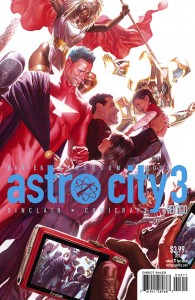 Astro City #3 — Writer: Kurt Busiek; Art: Brent Eric Anderson
Astro City #3 — Writer: Kurt Busiek; Art: Brent Eric Anderson
Same song, different verse — except that Busiek and Anderson have been showing how to combine character and imagination into effective stories for over 20 years now. Astro City looks more standard-superhero than Walking Dead or Saga, but the heroes aren’t the focus; they’re window dressing for the real protagonists: the ordinary people who have to deal with a world where super powers and potential global destruction are as commonplace as political scandals or celebrity gossip. Pick up the last issue and this one, a two-part tale about a young woman who gets a job at a helpline run by an Avengers-type group, and see if you aren’t hooked. Even more than Vaughan/Staples and Kirkman/Adelard (because they’ve been partners longer), much of the comic’s attraction is that Busiek/Anderson create such a fully-realized world for their readers; they make it easy to get pulled into it, and marvel at its down-to-earth sense of history, scope and realism, no matter what fantastic events are taking place overhead.
Buffy the Vampire Slayer: Season Nine #24 (of 25) — Writer: Andrew  Chambliss; Pencils: Georges Jeanty; Inks: Dexter Vines
Chambliss; Pencils: Georges Jeanty; Inks: Dexter Vines
This is the mirror image of Walking Dead: TV show first, and then comic; it’s similar to the other books here because of its strong fan base (deliberately nurtured by creator Joss Whedon) and emphasis on character. As far as I know, it’s also the first comic to “continue” a TV series, at least in such a linear way, where Whedon’s plans for the eighth season of the cancelled show were translated right into the comic instead, and fans followed happily along and made the book a hit. Of course, Buffy was a good candidate for this, since its characters aged in something close to real time and each of its seasons had an overall arc anyway, and Whedon, executive producer of the show, has ended up in much the same role in the comic version. This particular issue is the penultimate one of the ninth “season” (with a tenth announced for later), so it’s not the place to start, but anyone who liked the TV version will probably like the comic too. The eighth “season” had a lot of pyrotechnics — hundreds of slayers gathered into armies, world-shattering (and creating) events, etc.; you got the feeling that Whedon, liberated from the special-effects budget constraints of the actual show, went a tad overboard, and so the current run has had a lot of quieter moments, and has been working to get things back to a more recognizable and manageable status quo. The last few issues have upped the ante again, though, and as the series races to its conclusion it promises the same action, humor, hard choices and humanity that its fans have come to expect.
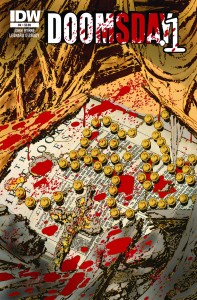 Doomsday.1 #4 (of 4) — Creator: John Byrne
Doomsday.1 #4 (of 4) — Creator: John Byrne
This mini-series is worth noting because it’s been Byrne returning to his first real professional work; it’s a prequel to Doomsday +1, the post-apocalyptic Charleton series that pre-dated his first Marvel superhero books in the ’70s. Although the current series’s first issue was on a larger scale, showing the origins of the ruined earth, this final issue has a smaller one, focusing on a small band of survivors in the South American jungle, a year after the crisis, and setting things up for a Doomsday.2 sequel. Byrne’s a well-known quantity, with his straight-ahead, carefully-constructed plots and crystal-clear art, and he definitely knows how to tell a story (he’s been doing it for a long time); for fans wondering what he’s been up to, this is a series worth checking out.
Killjoys #3 (of 6) — Writers: Gerard Way and Shaun Simon; Art: Becky Cloonan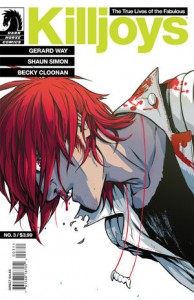
Another near-future story, not quite as apocalyptic as Doomsday.1, but not particularly hopeful either; think Blade Runner, but with less time spent in the big city and more in the desert open spaces around it. I’ve reviewed the first two issues previously here, so I’ll just reiterate that Gerald Way (and Simon, his writing partner) bring imagination and social satire in extrapolating the future stuff, and that Becky Cloonan is a national treasure — she has a particular knack for outsiders and offbeat landscapes, and I’d read just about any comic she was drawing, from this to Conan to Pirates of Coney Island to Demo.
 East of West #5 — Writer: Jonathan Hickman; Art: Nick Dragotta
East of West #5 — Writer: Jonathan Hickman; Art: Nick Dragotta
Infinity #1 (of 6) — Writer: Jonathan Hickman; Pencils: Jim Cheung; Inks: Mark Morales with John Livesay, David Meikis and Jim Cheung
Hickman offers a bridge between the indy and corporate comics, since he has one of each out this week; East of West is his own (with Dragotta), and this fifth issue makes clear that it’s at least partly a love story, about the personification of Death, his one-time lover (a Chinese woman warrior), and their son, who’s been kidnapped by those who want to use him as an agent of the Apocalypse. What’s really going on? Why is Death’s skin pitch-black in the flashback sequences, but he’s an albino now? Who are all those other characters? Hickman being Hickman, the answer’s aren’t clear yet, but the individual scenes and hints are so compelling (thanks to Dragotta’s confident art) that readers shouldn’t mind having to wait.
Infinity is Marvel’s big fall event, and here Hickman’s complex approach to 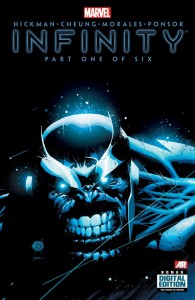 storytelling miught work against him — anyone reading this cold, without any knowledge of the last year’s worth of Avengers and New Avengers comics, will be very confused. Who are the Builders? When did characters called Ex Nihilo, Manifold, Abyss and Smasher join the Avengers — not to mention Marvel-Earth versions of Starbrand and Nightmask (from the ’90s New Universe books), and a female Captain Universe? Throw in the Inhumans, the Illuminati, S.W.O.R.D. and various Spacenights (not to mention Skrulls and the cover-featured big bad guy of the piece, Thanos), and that’s a lot of balls being juggled at once. On the other hand, maybe that’s too much overthinking: all you really need to know is that the Builders are very powerful and world-destroying aliens, that they’re far out in space, kicking everybody else’s butt and headed toward earth, and that the heroes have to go meet them and keep them away — and that Thanos, as always, is planning on using all of this for his own dark purposes. Can Hickman make it all work? Will readers mind investing in six issues of this, plus six issues of Avengers and four of New Avengers, to get the story? With 45 pages of crisp-looking Cheung art (plus another nine of full-page chapter headings and charts), for $4.99, this first issue makes a good case; if you’re any kind of Avengers fan, how can you not pick it up and see?
storytelling miught work against him — anyone reading this cold, without any knowledge of the last year’s worth of Avengers and New Avengers comics, will be very confused. Who are the Builders? When did characters called Ex Nihilo, Manifold, Abyss and Smasher join the Avengers — not to mention Marvel-Earth versions of Starbrand and Nightmask (from the ’90s New Universe books), and a female Captain Universe? Throw in the Inhumans, the Illuminati, S.W.O.R.D. and various Spacenights (not to mention Skrulls and the cover-featured big bad guy of the piece, Thanos), and that’s a lot of balls being juggled at once. On the other hand, maybe that’s too much overthinking: all you really need to know is that the Builders are very powerful and world-destroying aliens, that they’re far out in space, kicking everybody else’s butt and headed toward earth, and that the heroes have to go meet them and keep them away — and that Thanos, as always, is planning on using all of this for his own dark purposes. Can Hickman make it all work? Will readers mind investing in six issues of this, plus six issues of Avengers and four of New Avengers, to get the story? With 45 pages of crisp-looking Cheung art (plus another nine of full-page chapter headings and charts), for $4.99, this first issue makes a good case; if you’re any kind of Avengers fan, how can you not pick it up and see?
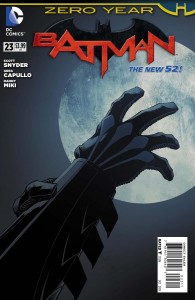 Batman #23 — Writer: Scott Snyder; Pencils: Greg Capullo; Inks: Danny Miki
Batman #23 — Writer: Scott Snyder; Pencils: Greg Capullo; Inks: Danny Miki
If you’re going to title your arc “Batman: Year Zero,” then it’s given that, at some point in the narrative, a furry flying mammal is going to crash through Bruce Wayne’s window. That was accomplished in one panel in 1939, but of course today it involves a bleeding and beaten Bruce Wayne (he’s wearing a smoking jacket in the original, just lounging around in his rich-guy mansion), a whole flock of bats instead of an outlier, and three issues. Fair enough: Snyder’s become very confident in his moves now (having the best-selling regularly-published comic pretty much every month for the last two years will do that), and Capullo was born to draw Batman comics: they’re uniquely suited to his dramatic page layouts and shadow, silhouetted style; the full-page money shot here, of the bats coming through the window, really does resonate.
Justice League of America #7 — Writers: Geoff Johns and Jeff Lemire; Pencils:  Doug Mahnke; Inks: Five different guys
Doug Mahnke; Inks: Five different guys
“Trinity War,” part four of six. So, it’s becoming clear that this series won’t resolve by itself; it appears to be an attempt by the bad guys to knock out the heroes’s big three of Superman, Batman and Wonder Woman, plus all the JLs, as a prelude to a takeover of all the DC titles by DC’s villains in September (the one where every book will change its name to a villain’s and have a 3-D animated cover image of that character). That, in turn, will lead to “Forever Evil,” a title whose plot should be obvious. That’s all a long haul for readers, but since this is the New 52 DC’s first big event, some overkill can probably be forgiven (admit it: if you’re enough of a DC fan to be reading any number of these comics anyway, you’re going to go for it, just like Marvel fans are going to buy Infinity...).
 Uncanny X-Men #10 — Writer: Brian Michael Bendis; Art: Frazier Irving
Uncanny X-Men #10 — Writer: Brian Michael Bendis; Art: Frazier Irving
The normal superhero soap opera from Bendis — it suffers a little from not having the superb Chris Bachalo on art, but Irving (who’s been spelling him on the pencils, having also done issues six and seven) is OK; he’s more in the Alex Maleev vein, with a talent for individualized faces, so he works particularly well in the crowd scenes here (in fact, with its Occupy-style speeches and crowd support for the mutants, this has some similarities to the Bendis/Maleev Scarlet). Irving is more of a total package, too — where Bachalo only does pencils, often with multiple inkers, he provides both inks and coloring, making the world within the comic feel more consistent and organic.
Wolverine #8 — Writer: Paul Cornell; Pencils: Alan Davis; Inks: Mark Farmer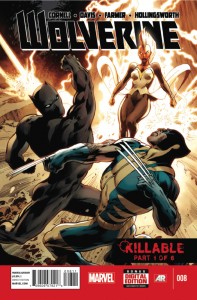
This begins a six-part saga called “Unkillable,” one which is supposedly going to lead to the “death” of Wolverine, since his mutant healing factor no longer works. I like Davis’s careful, Adams-like art better when he’s not writing his own stuff, and Cornell is a dependably-sophisticated scripter, so this should be OK — although the premise is, obviously, impermanent and even silly (Marvel announced the storyline at about the same time they revealed that Nightcrawler, another mutant who’s been “dead” for awhile, would be coming back), and it’s hard to read a comic when you keep rolling your eyes.
 Wolverine and the X-Men #34 — Writer: Jason Aaron; Pencils: Nick Bradshaw; Inks: Walden Wong
Wolverine and the X-Men #34 — Writer: Jason Aaron; Pencils: Nick Bradshaw; Inks: Walden Wong
Thor, God of Thunder #11 — Writer: Jason Aaron; Art: Esad Ribic
Two by Aaron — Wolverine offers the fourth of a five-part Kid Hellfire Club tale, and shows how good he is at combining thrills and humor, and at handling stories with lots of moving parts; Bradshaw, who’s asked to do things like a two-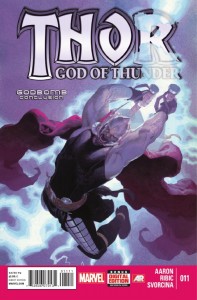 page splash involving five heroes, six giant Krakoa monsters and assorted Bamfs, delivers nicely. Thor concludes the “Godkiller” story that’s been running since the title relaunched; Aaron’s made it both grimmer, more focused and more cosmic than Wolverine (which suits Ribic’s Conan-style art), and his three past/present/future versions of Thor, and their apocalyptic adversary, have made for an effective launch for this comic.
page splash involving five heroes, six giant Krakoa monsters and assorted Bamfs, delivers nicely. Thor concludes the “Godkiller” story that’s been running since the title relaunched; Aaron’s made it both grimmer, more focused and more cosmic than Wolverine (which suits Ribic’s Conan-style art), and his three past/present/future versions of Thor, and their apocalyptic adversary, have made for an effective launch for this comic.



